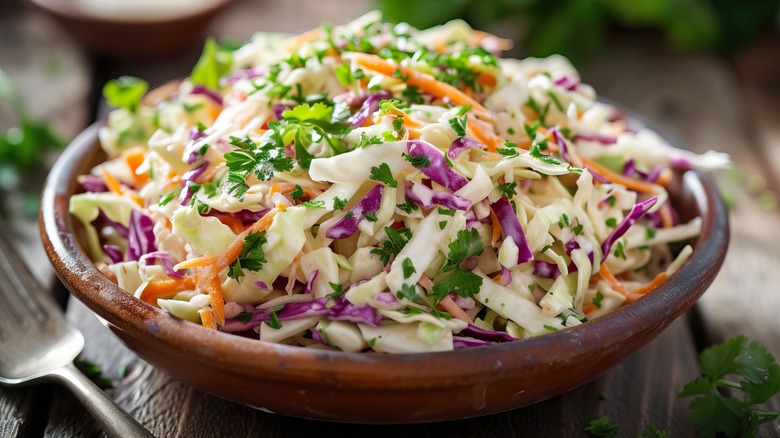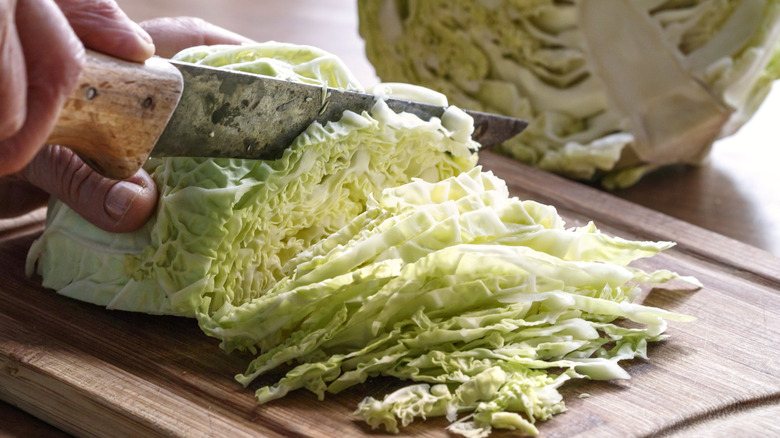The Ancient Origins Of Coleslaw (And How It Got Its Name)
No backyard cookout, barbecue, or platter of smoked meats is complete without a side of coleslaw. It's delicious no matter how you make it, and Daily Meal has counted no less than 13 distinctly different types of coleslaw. Although they're made with a variety of dressings and ingredients, they all have one thing in common: cabbage. That's been around for a long, long time, and it turns out that for as long as people have been growing cabbage, they've been turning it into coleslaw.
Head over to ancient Greece, and you'll find that cabbage has been an important crop for at least 2,600 years. It was valued not only as a food but for medicinal properties, and it turns out that tracing the cabbage family back to its wild roots and ancestors is pretty complicated. Still, one of the best stories might come from the ancient Greeks, who said that the first cabbages grew from the places where Zeus's sweat dripped onto the ground. Yum!
When it comes to coleslaw, the widely accepted opinion is that it was the ancient Romans who first served up a dish that we would recognize as coleslaw. It wasn't called coleslaw then, and figuring out just how that particular name came about is more than a little complicated.
An ancient Roman recipe helped introduce coleslaw to the world
While no one is 100% certain just how cabbage spread across Asia, the Mediterranean, and into Europe, it's generally thought to have been introduced into new areas by either the ancient Romans or the ancient Celts — and it's pretty wild to think that the Romans were already making coleslaw.
A recipe for a coleslaw-like dish can be found in Apicius's "Cooking and Dining in Imperial Rome," which is believed to be one of the oldest cookbooks in history. It's unclear if it's meant to be a hot or cold salad, but it's essentially cabbage that's sliced and seasoned in various ways, with one recipe calling for adding oil, stock, cumin, peppers, leeks, and green coriander.
They may have been enjoying it, but they weren't calling it coleslaw. That word didn't come around for a long, long time, and in fact, it wasn't used until the late 18th century. It started out as a Dutch word — koolsla — that translates literally to cabbage salad, and interestingly, we didn't immediately start calling it coleslaw. The term "cold slaw" came first, and in some places, it was known as "cold slaugh." It's thought that coleslaw became the widely accepted version of the name in part due to a connection with the Latin word for cabbage, caulis.
The Dutch brought coleslaw to the U.S.
It's reasonable to question why English-speakers now use a term derived from a Dutch word for this sliced and dressed cabbage salad — and it goes back to Dutch settlers. The area around New York's Hudson Valley was perfect for growing cabbage, and their koolsla (or koosla) became a pretty popular dish.
That's a fascinating bit of foodie history that's been preserved in books like Adriaen van der Donck's "A Description of New Netherland (The Iroquoians and Their World)." He noted that by 1655, cabbages — and other fruits and vegetables like turnips, peas, and apples — had been well established in the Hudson Valley, and they weren't just growing one kind, they were growing red, white, green, and savoy cabbage. Similarly, the book "The Sensible Cook" gives more of an insight into what settlers were making. First published in 1667, the book went through multiple editions and gave an early recipe for what would morph into coleslaw: It called for butter, oil, and vinegar.
The final piece of the coleslaw puzzle came along in the middle of the 18th century, when mayo was invented in either France or Spain. (There's compelling evidence for both claims.) While America slathered mayo on their cabbage and never looked back, other countries have their own beloved versions of coleslaw. If you love America's, you're bound to love others. Start by giving your coleslaw a Greek twist by using tzatziki as your base. You're welcome!


